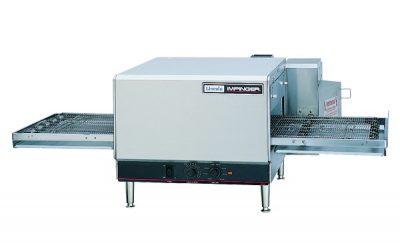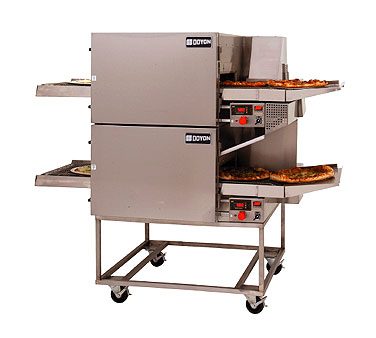Choosing a Deck Oven or a Conveyor Oven
Mar 9th 2012
Which oven is best for your operation, a deck or a conveyor oven?
Both styles of ovens have features sets providing different benefits for its operators. Choosing which oven is best for your operation depends on your restaurant's individual needs and sometimes requires making choices and accepting compromises.
A deck oven will lend itself to a wider variety of menu items. If deck ovens are managed properly, a chef can determine how well cooked nearly any menu item is, often cooking several different products simultaneously. This method does, however require greater skill by the operator / chef and almost constant oven tending.
Conversely, a conveyor oven requires far less skill to operate, and in turn reducing labor costs and giving the owner / operator access to a greater, less expensive labor pool. Conveyor ovens require a lower degree of skilled kitchen labor, operators find that they save money by reducing training time and hiring less expensive employees. Since turnover is turnover rampant in the foodservice industry, getting the right person trained quickly continues to be a challenge in most restaurants.

Conveyor ovens do not require constant tending, which allows the kitchen staff to multi-task providing additional labor savings. Owners realized that their employees could load food products and perform other chores while the product traveled through the conveyor.
Restaurant owners figured that pre-setting time and temperatures, conveyors can produce constant and consistent baking results. This consistency also provides standardization of product taste and appearance which is important to multi unit or chain operations. This consistency, however, is not always a given. Conveyor ovens do not totally eliminate user errors or make the results ‘fool-proof’. Conveyor ovens have bake times and oven temperatures pre-set for specific menu items, portion size, and consistency ingredients. Product consistency is only achieved when there is product consistency during the prep process. Portion control is critical. Even holding temperatures of your food prior going into a conveyor oven can have an impact on the final resulting quality. Another thing that is imperative is that products must pass through the entire conveyor oven and be allowed to complete their full cook cycle. Low-cost, inexperienced labor can still contribute to inconsistencies in the final product quality.
Deck ovens can also provide a consistent product, but baking conditions will fluctuate based on how many times doors open and based on the products going into the oven.
When cooking with conveyor ovens, the three most common types of oven cooking technology are forced air impingement, radiant electric elements, and infrared electric elements.
Forced air impingement is the most widely type of cooking since it can reduce your total cooking time by 20% to 25% as compared non-forced air ovens. Some of the downsides of a forced air impingement oven is that they tend to be loud making them less suitable for use in customer areas. Additionally, they have fixed air panels which are difficult to change making them less flexible for establishments that have a variety of menu items.
Radiant and infrared conveyor ovens, just like deck ovens, are extremely quiet making them ideal for locations where customers are near.
Since air flow, temperatures, and time are not easily adjusted on most types of conveyor ovens, one would see them mostly used in high volume operations where the menu items are limited. Conveyors have become most widely used in chain pizza businesses, the take-home, and delivery restaurants. Deck ovens, on the other hand, can cook and bake nearly any menu item, and are most applicable for casual family dinning and full-service, larger-menu operations as well as pizza operations.
 Some establishments will have dual conveyor ovens to allow for different air flows, speeds, and temperatures and to increase the flexibility to offer more menu items. Recently, some manufacturers have upped the ante even more by having split belts, allowing the operator to have one cooking chamber but have two cooking times. Each belt would then be used for different items on the menu.
Some establishments will have dual conveyor ovens to allow for different air flows, speeds, and temperatures and to increase the flexibility to offer more menu items. Recently, some manufacturers have upped the ante even more by having split belts, allowing the operator to have one cooking chamber but have two cooking times. Each belt would then be used for different items on the menu.
If you are using a conveyor or deck oven, they can both be stacked allowing the operator to increase production without using valuable space within the kitchen. Depending on the oven, they can be stacked two, three or sometimes even four high. While flexibility is a mainstay with deck ovens, a stack of conveyor ovens can allow the operator use different ovens at different temperatures, air flow, allowing for more flexibility and menu options.
Based on the chef, deck ovens will typically give a superior gourmet quality end result, especially for crusts in baking, be it pizza, flat breads or loaves giving a crispy quality when baked directly on the hearth deck. If a forced air oven impingement type of oven was used, it would have a drying effect on the product. Steps need to be taken to compensate for this during the planning and formulation of the recipes to overcome this tendency. In some applications, you would want this drying effect. Forced air impingement drastically speeds the cooking and baking process by pulling moisture from the product’s surface. This reduces the total cooking time by as much as 20% to 25%. Just like a convection oven, the forced air will speed the cooking and baking process when compared to conventional ovens.
While forced air impingement reduces the overall cooking time; a deck oven will provide the operator a greater production capacity at a much lower cost within a smaller footprint. An operator can estimate that a deck oven will provide roughly double the production of a conveyor oven at ½ to ? of the total cost.
Even though deck ovens are designed for higher production, the must be manned properly to get these higher production yields. The conveyor oven would be a high tech option compared to the deck oven. Deck ovens have no moving parts, fans, or motors making downtime much less if there ever is a problem.
In summary, a conveyor oven will be more expensive, will require a larger footprint in the kitchen, are more prone to break, require more maintenance, are more difficult to keep clean, output less volume, and will most of the time, consume more energy than traditional ovens. With all these negatives, the benefit of minimizing labor costs, using less skilled labor, reducing training requirements and producing consistent results have given operators reasons to embrace their benefits.
Deck ovens have greater ambiance for applications requiring display cooking in open kitchens. Deck ovens are now offered with stone, brick and tile facades, arched openings and visible open-flames. Deck ovens can become the center piece of restaurants providing a great attraction for customers.
Source – Bakers Pride
